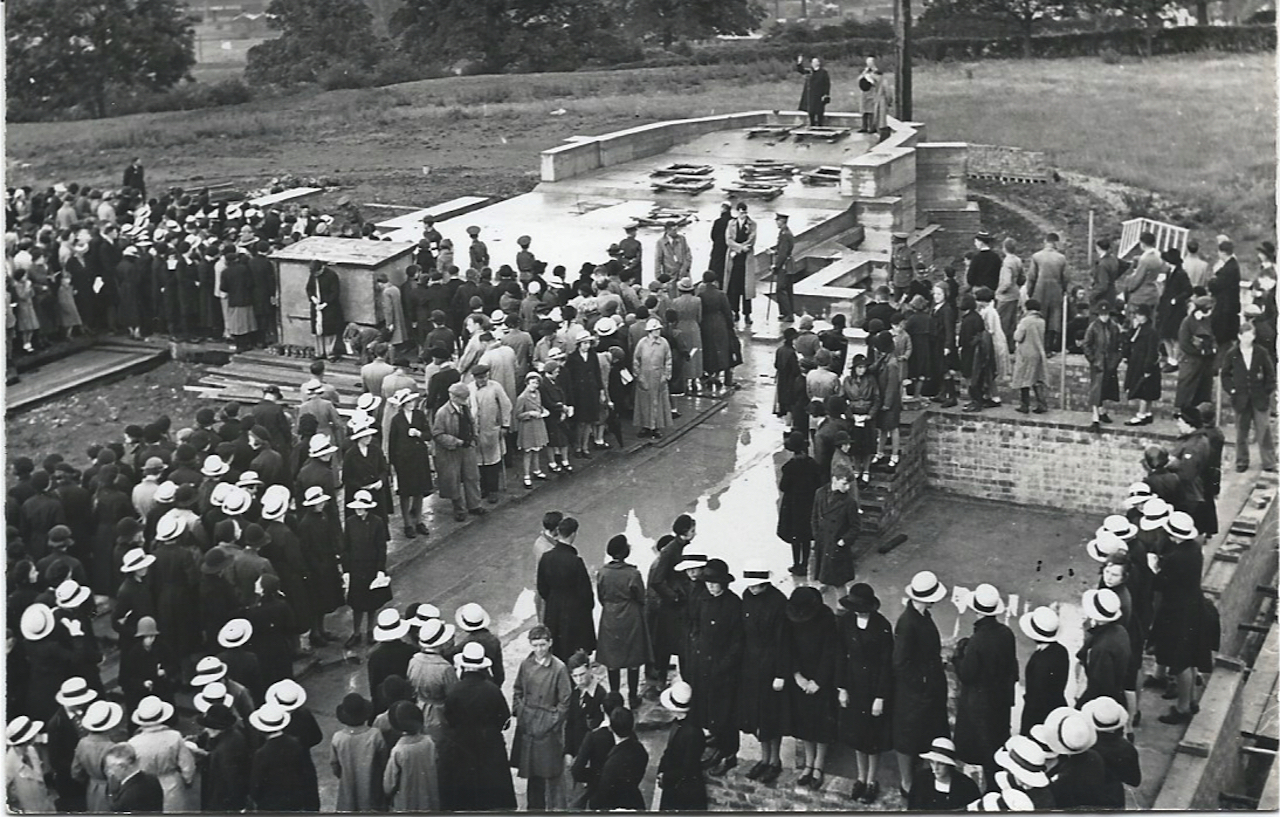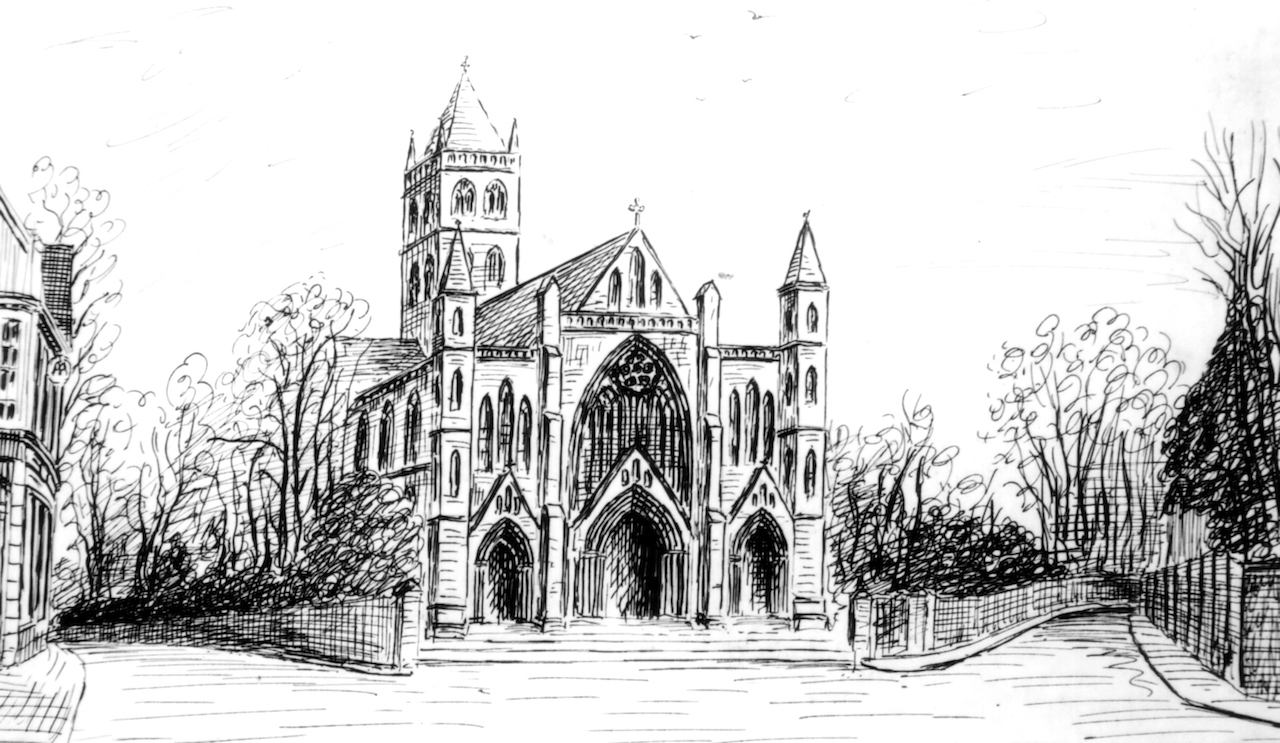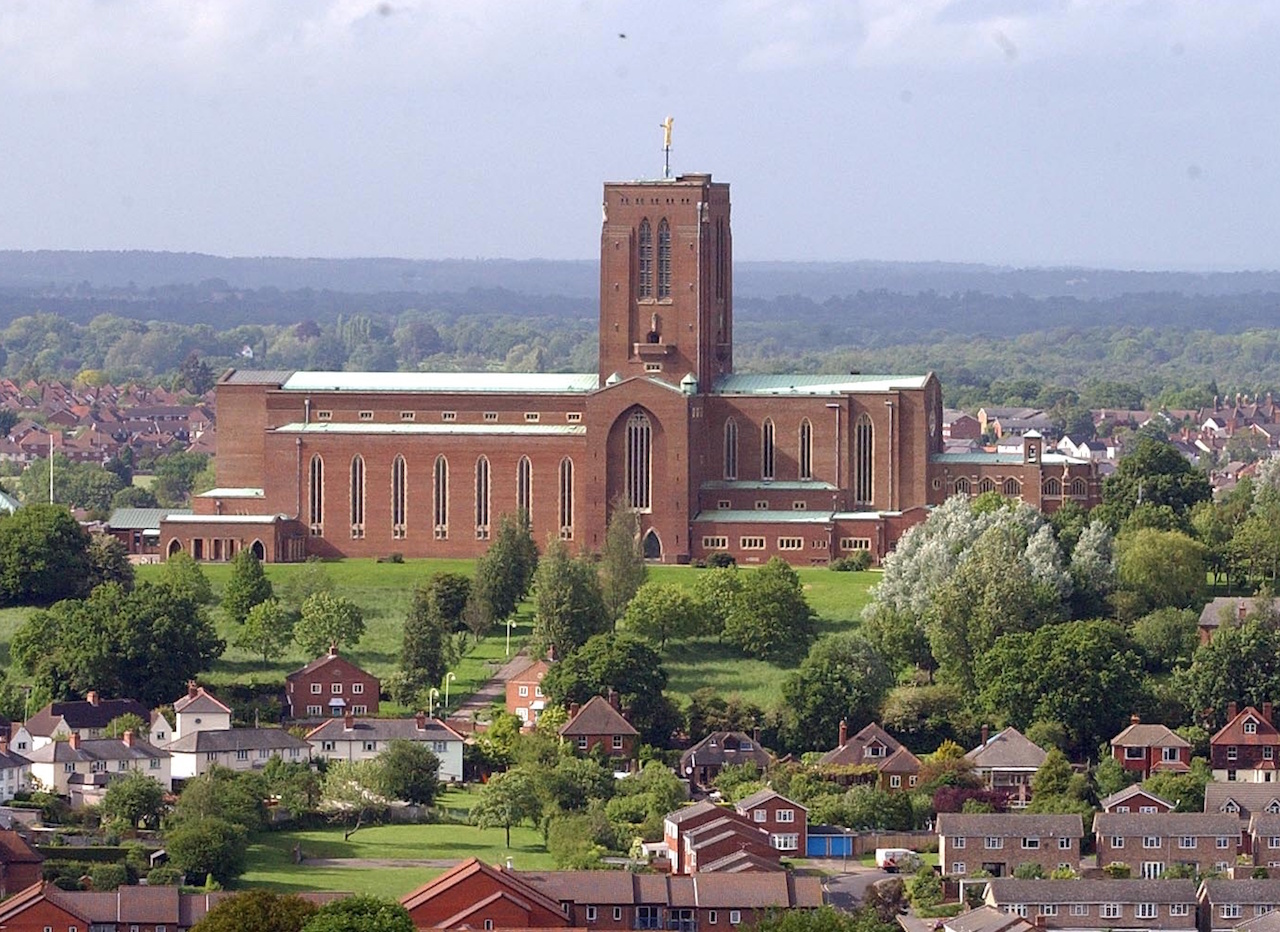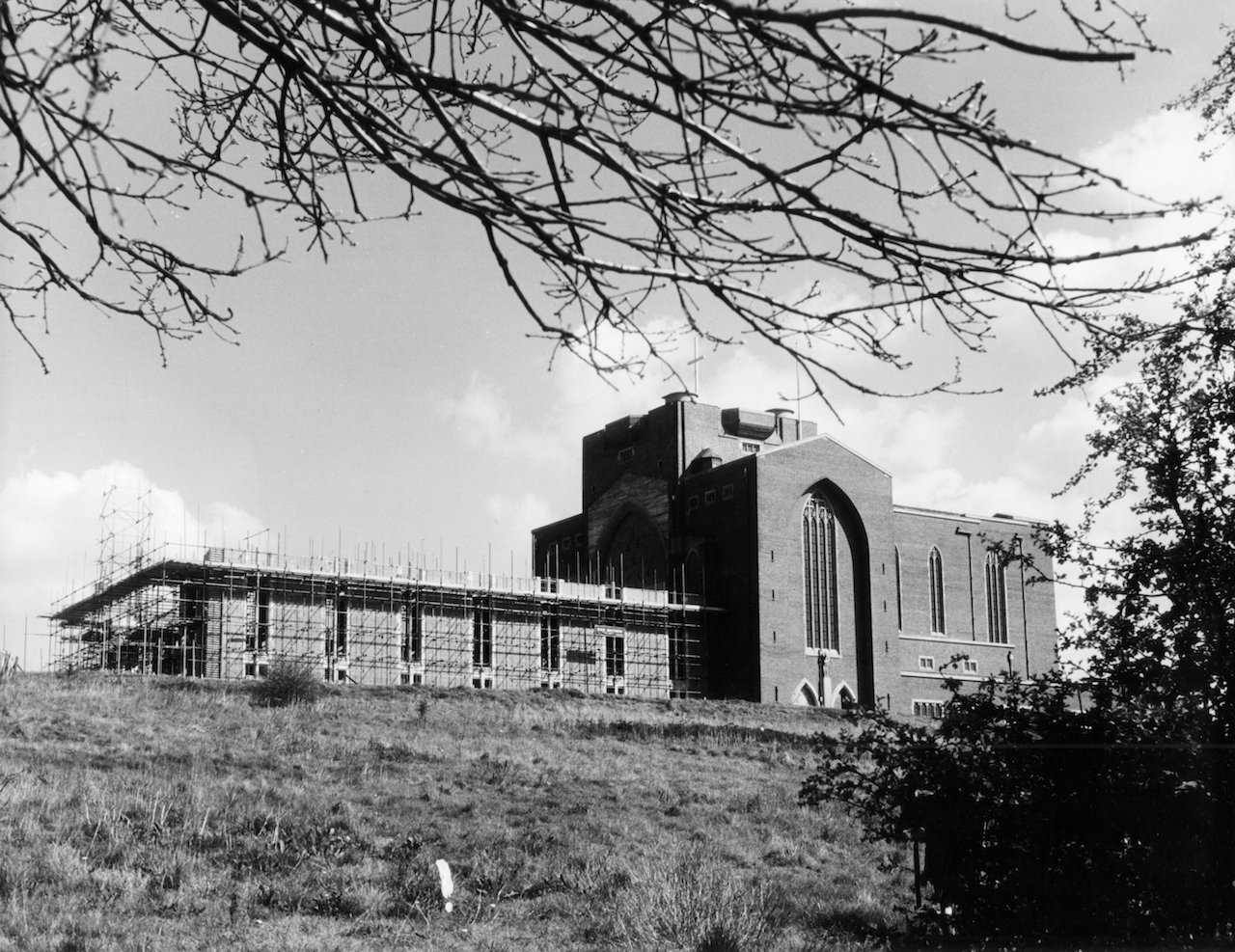 Abraham Lincoln
If given the truth, the people can be depended upon to meet any national crisis...
Abraham Lincoln
If given the truth, the people can be depended upon to meet any national crisis...
 Guildford news...
for Guildford people, brought to you by Guildford reporters - Guildford's own news service
Guildford news...
for Guildford people, brought to you by Guildford reporters - Guildford's own news service
Opinion: Was Our Cathedral a Mistake From the Start?
Published on: 19 May, 2017
Updated on: 22 May, 2017
By Anthony Jacques
Fundamental errors were made by the Church of England when they created the Diocese of Guildford. And it did not stop there.

A service of blessing at the beginning of the building of Guildford’s Cathedral of the Holy Spirit in the 1930s.
A decision was made in the late 1920s that a new diocese should be formed from the eastern part of Winchester diocese. This was the most recent of such new English dioceses, although over 30% of dioceses and, of course their cathedrals, are of 19th- or 20th-century origin.
But in almost all earlier cases a cathedral was formed by extension or adaptation of an existing church, and in every case the new cathedral, extension or new build, was located in the centre so as to continue serving that borough and community.
 Holy Trinity has been the premier church for Guildford for centuries, but although it served as the pro cathedral for some years, it was deemed too small and not compatible with extensions at either end.
Holy Trinity has been the premier church for Guildford for centuries, but although it served as the pro cathedral for some years, it was deemed too small and not compatible with extensions at either end.

A sketch of how Guildford Cathedral may have looked if built in the town centre at the junction of London and Epsom Roads. Click on all pictures to enlarge in a new window.
So for a new cathedral at least two other sites were initially considered, Pewley Hill, less developed at the time, and the site where G Live now stands. But did we ever need a big new building capable of seating 1,000 or more?
Lord Onslow offered Stag Hill to the diocese, some 150 acres on the west of the town, both for a new cathedral and as a perpetual open space for the people of Guildford.
Building began in 1936. Even then it was known that it would be a long project because funds needed to be raised as the walls went up – not perhaps the best business practice.
The idea was that this grand new building, visible from afar, would be a centre of worship as housing expanded to the west and north of the town.

View from above with Guildford Cathedral partly built as work was interrupted during the Second World War. An oil painting by Ernest Moseling of Guildford.
Then the Second World War intervened. Construction stopped and did not restart until 1950.
With further rising costs and changed times, one wonders whether the project should have been abandoned then, leaving perhaps a small chapel on the hill, and a park for all to enjoy around. But no, they pressed on. Meanwhile, because there was no place of worship for the expanding housing around, small churches were built for the new estates.
This denied the cathedral one of the roles it had been sited to meet – a modern cathedral, in a new setting, with lots of parking, and with its own worshipping community around it.
I have lived and worshipped in Guildford, attending a variety of churches, for nearly 40 years. At the cathedral I have experienced normal Sunday worship and large services for special occasions. I still feel that it has never found a role.
The borough church remains Holy Trinity, the cathedral has a small, loyal, regular congregation, but is only filled for ordinations, big memorial services and periodic protocol occasions.
Shortage of funds requires careful stewardship. One spring weekday six years ago, my wife took two Tanzanian visitors along to evensong so they might experience a taste of ‘English cathedral worship’. There was a full choir, the whole place was heated and lit, and they were the sole congregation. From an ecological perspective, let alone a financial one, this seems scandalous.

A fine view of Guildford Cathedral seen from The Mount and taken before the recent restoration work was started.
Now the cathedral hopes to sell a portion of Lord Onslow’s gift to a developer for housing. Is this to pay for current or ongoing maintenance, to establish a lasting endowment, or is it sheer desperation?
The planning application was turned down by the Guildford Borough Council to the relief of many. Guildford Vision Group and local residents’ associations have put forward cogent arguments against that development and well-reasoned plans as to how ‘the two halves of the town’ may be better joined but such matters are not within the remit of this article.
Suffice to say the development plan would seem to be the culmination of a series of errors of judgment over the last 80 years. Is it not time that the dean and chapter threw in the towel?
Responses to Opinion: Was Our Cathedral a Mistake From the Start?
Leave a Comment Cancel reply
Please see our comments policy. All comments are moderated and may take time to appear. Full names, or at least initial and surname, must be given.
Click on cartoon for Dragon story: Public Asked for Views on SCC’s Proposal for Reduced Speed Limits


Recent Articles
- Thousands of Year Six Pupils at Guildford Cathedral for a Special Send Off
- New Surrey Research to Find Solutions to Local Challenges
- Comment: What Are We To Make of the GBC Executive ‘Reshuffle’?
- Bensons for Beds Opens New Store on Guildford High Street
- Local MPs Vote in Favour of Assisted Dying
- Merger Between Reigate & Banstead and Crawley Councils Ruled Out
- ‘Politics Is Not Always a Kind Place’ Says Dismissed Lead Councillor
- Letter: It’s Almost Like We Have Been Abandoned By the Council
- Failure of Woking’s Over-ambitious Project Acknowledged
- Comment: What Can Be Done About Guildford’s Biggest Empty Shop?


Recent Comments
- John Redpath on ‘Politics Is Not Always a Kind Place’ Says Dismissed Lead Councillor
- Jules Cranwell on ‘Politics Is Not Always a Kind Place’ Says Dismissed Lead Councillor
- Ben Paton on ‘Politics Is Not Always a Kind Place’ Says Dismissed Lead Councillor
- Angela Gunning on ‘Politics Is Not Always a Kind Place’ Says Dismissed Lead Councillor
- Nigel Keane on A281 At Shalford Has Now Reopened Following Repairs to Damaged Roof
- N Hatcher on New Electric Trains Now Arriving at Guildford – 100 Years After the First One Did
Search in Site
Media Gallery
Dragon Interview: Local Artist Leaves Her Mark At One of England’s Most Historic Buildings
January 21, 2023 / No Comment / Read MoreDragon Interview: Lib Dem Planning Chair: ‘Current Policy Doesn’t Work for Local People’
January 19, 2023 / No Comment / Read MoreA3 Tunnel in Guildford ‘Necessary’ for New Homes, Says Guildford’s MP
January 10, 2023 / No Comment / Read More‘Madness’ for London Road Scheme to Go Ahead Against ‘Huge Opposition’, Says SCC Leader
January 6, 2023 / No Comment / Read MoreCouncillor’s Son Starts Campaign for More Consultation on North Street Plan
December 30, 2022 / No Comment / Read MoreCounty Council Climbs Down Over London Road Works – Further ‘Engagement’ Period Announced
December 14, 2022 / No Comment / Read MoreDragon Interview: GBC Reaction to the Government’s Expected Decision to Relax Housing Targets
December 7, 2022 / No Comment / Read MoreHow Can Our Town Centre Businesses Recover? Watch the Shop Front Debate
May 18, 2020 / No Comment / Read More







Mike Adams
May 20, 2017 at 1:29 am
Anthony Jacques analysis is well considered. With Anglicanism in seemingly terminal decline (evident from ever shrinking and ageing congregations) the cathedral can never hope to demonstrate it has a useful role in the local community. Even as a public venue for secular events such as music concerts it fails due to awful acoustics which cannot do justice to our local choirs and orchestras, compared to our excellent G Live venue.
Holy Trinity in comparison is a good example of a popular church building which works well for both religious and secular purposes.
Jeff Bott
May 22, 2017 at 12:09 pm
Convert the cathedral into multiple apartments by adding some internal floors. These can address the housing demand and the COE can use the sale proceeds to maintain their remaining vast property portfolio. This will also prevent more unsightly development on land gifted to the Church of England people of Guildford.
Stuart Barnes
May 22, 2017 at 6:09 pm
Although the cathedral is not beautiful nor ancient I believe that it should be protected and preserved. I am not well up in the politics of listing and thus protecting buildings but it seems more deserving than some of the recent listings.
In any case, an important city like Guildford should have a cathedral. Isn’t it a requirement to be accepted as a city and isn’t it time that Guildford became the principal city of Surrey?
In fact, Guildford is not a city despite having a cathedral and a university. To become a city a town requires the monarch to grant “letters patent”. Most accept though that Guildford is the county town of Surrey already, which stems from a charter granted by Henry III in 1257, marking Guildford’s status as the county town of Surrey. Although Surrey County Council is based in Kingston and the assizes were moved there in 1930, Kingston is now a London Borough no longer in Surrey. See also: Is Guildford Definitely Surrey’s County Town? Ed
Dave Middleton
May 24, 2017 at 8:40 pm
I for one do not want Guildford to become a city, with yet another layer of bureaucracy and expense to be paid for by me and the other local taxpayers. Guildford is a county town and long may it remain so.
If anyone wants to live in a city, they should move.
Howard Moss
May 23, 2017 at 4:05 pm
I agree with the writer’s comments, your readers will recall that the case for the 134 flats and houses on the side of the cathedral was based on a lack of funding. So it is interesting to read in a newspaper today that the Church of England has £8 billion of assets and paid fund managers £230 million.
I do not accept the missive that the church only pays for some of its staff and not for its buildings, especially when they have £8 billion of assets.
John Storry
May 24, 2017 at 3:51 pm
The ESSOLDO of Anglicanism has a certain charm – long may it stand on the hill!
Essoldo Circuit cinemas, at one time Britain’s third-biggest cinema chain after The Odeon and ABC, often had art deco architecture and flamboyant use of neon lighting outside, with the double S’ of the name styled in what Charles Morris describes as “a languorous” fashion with an “air of fallen grandeur” inside. Ed
Donna Collinson
May 25, 2017 at 12:11 am
Perhaps Guildford Cathedral is destined to follow in the footsteps of that other iconic modernist Grade II* listed building Battersea Power Station. It was brick built on the 200 acre Battersea Park in two phases as the cathedral 1930s and 1950s, interrupted by the war, and featured a lavish interior.
Neglected for years. It’s fallen grandure now restored, converted into apartments and offices, Historic England supporting its change of use rather than seeing it crumble on the At Risk Register due to lack of funds to maintain it.
Yes, long may the cathedral stand on the hill, though it may not be beautiful, in the way of old cathedrals like St. David’s, Canterbury, or Exeter. However even if it is not included in this coming Local Plan, consider it for future use, with housing and offices inside, whilst keeping the outside a much needed public open green space as it was originally gifted and intended.
David Roberts
May 26, 2017 at 9:11 am
The Church of England made an impressive 17% on its investments last year, yet we are told they can’t afford to maintain this ugly white-elephant of a cathedral without selling their souls to housing developers.